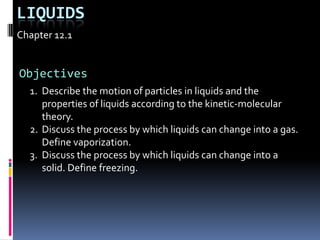Chapter 12.1 : Liquids
•Télécharger en tant que PPTX, PDF•
2 j'aime•1,031 vues
Signaler
Partager
Signaler
Partager

Recommandé
Recommandé
Contenu connexe
Tendances
Tendances (20)
En vedette
En vedette (20)
Introduction to Science 3.1 : Exploring Physical Science

Introduction to Science 3.1 : Exploring Physical Science
Similaire à Chapter 12.1 : Liquids
Similaire à Chapter 12.1 : Liquids (20)
Chapter 1 kinetic particle theory notes ( class test )

Chapter 1 kinetic particle theory notes ( class test )
Plus de Chris Foltz
Plus de Chris Foltz (20)
Earth Science 3.3 : Absolute Dating: A Measure of Time

Earth Science 3.3 : Absolute Dating: A Measure of Time
Earth Science 3.1 : Earth's Story and Those Who First Listened.

Earth Science 3.1 : Earth's Story and Those Who First Listened.
Earth Science 3.2 : Relative Dating : Which Came First?

Earth Science 3.2 : Relative Dating : Which Came First?
Dernier
Mehran University Newsletter is a Quarterly Publication from Public Relations OfficeMehran University Newsletter Vol-X, Issue-I, 2024

Mehran University Newsletter Vol-X, Issue-I, 2024Mehran University of Engineering & Technology, Jamshoro
Making communications land - Are they received and understood as intended? webinar
Thursday 2 May 2024
A joint webinar created by the APM Enabling Change and APM People Interest Networks, this is the third of our three part series on Making Communications Land.
presented by
Ian Cribbes, Director, IMC&T Ltd
@cribbesheet
The link to the write up page and resources of this webinar:
https://www.apm.org.uk/news/making-communications-land-are-they-received-and-understood-as-intended-webinar/
Content description:
How do we ensure that what we have communicated was received and understood as we intended and how do we course correct if it has not.Making communications land - Are they received and understood as intended? we...

Making communications land - Are they received and understood as intended? we...Association for Project Management
Dernier (20)
Salient Features of India constitution especially power and functions

Salient Features of India constitution especially power and functions
UGC NET Paper 1 Mathematical Reasoning & Aptitude.pdf

UGC NET Paper 1 Mathematical Reasoning & Aptitude.pdf
ICT Role in 21st Century Education & its Challenges.pptx

ICT Role in 21st Century Education & its Challenges.pptx
Unit-V; Pricing (Pharma Marketing Management).pptx

Unit-V; Pricing (Pharma Marketing Management).pptx
Sensory_Experience_and_Emotional_Resonance_in_Gabriel_Okaras_The_Piano_and_Th...

Sensory_Experience_and_Emotional_Resonance_in_Gabriel_Okaras_The_Piano_and_Th...
Making communications land - Are they received and understood as intended? we...

Making communications land - Are they received and understood as intended? we...
Micro-Scholarship, What it is, How can it help me.pdf

Micro-Scholarship, What it is, How can it help me.pdf
HMCS Vancouver Pre-Deployment Brief - May 2024 (Web Version).pptx

HMCS Vancouver Pre-Deployment Brief - May 2024 (Web Version).pptx
This PowerPoint helps students to consider the concept of infinity.

This PowerPoint helps students to consider the concept of infinity.
Chapter 12.1 : Liquids
- 1. Liquids Chapter 12.1 Objectives Describe the motion of particles in liquids and the properties of liquids according to the kinetic-molecular theory. Discuss the process by which liquids can change into a gas. Define vaporization. Discuss the process by which liquids can change into a solid. Define freezing.
- 2. Liquids Examples: Oceans, lakes, rivers Hard to believe – liquids are the least common state in the universe Why? Narrow temperature range they can exist in!
- 3. Properties of Liquids and Kinetic-Molecular Theory Definite volume, take shape of container According to Kinetic-Molecular Theory Liquid’s particles are: In constant random motion Closer together than gases, there are attractive forces More ordered than gases, so particles are held together, but do have mobility. Fluid: substance that can flow and therefore take the shape of its container
- 4. Relatively High Density Thousands of times denser than gases Slightly less dense than solids Due to the close arrangement of liquid particles
- 6. Constant, random motion of particles
- 8. Evaporation and Boiling Vaporization: Process by which a liquid or solid changes to a gas Evaporation: Process by which particles escape from the surface of a non-boiling liquid and enter the gas state. Boiling: Change in liquid to bubbles of vapor that appear throughout the liquid.
- 9. Formation of Solids When liquid is cooled, average kinetic energy decreases Particles slow down Attractive forces pull into an orderly arrangement Freezing (solidification): Physical change of a liquid to a solid by removal of heat.